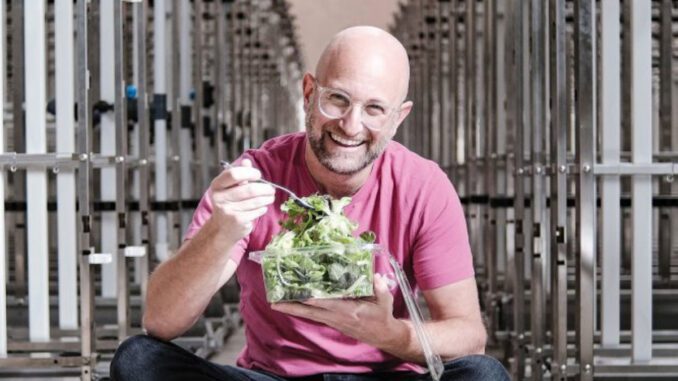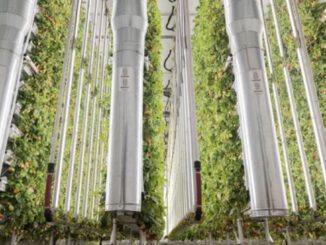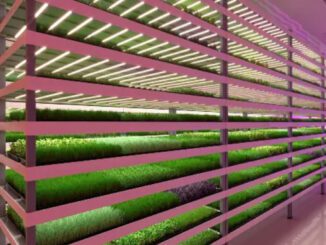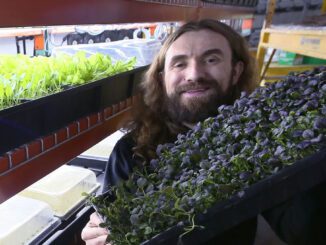
VERTICAL FARMING and the future of lettuce
Pros and cons of warehouse farming
Vertical Farming Pros Cons | Ed Hand and James Pascual |
IMAGE: Jon Lomow, CEO of Fieldless Farms, enjoys a salad at the company’s indoor growing facility in Cornwall.
CORNWALL — Canadians love their romaine lettuce. You can’t make a Caesar salad without it. But to eat it we need to import almost all of it.
Canada imports more than 500-million pounds of lettuce annually, mostly romaine. We import more lettuce by value than any other vegetable.
But with drought and an insect borne virus tearing through the California crops in Salinas Valley, the romaine yield dropped dramatically last year and the price soared in November. Much had been said on social media about an $8 head of iceberg lettuce and $15 for romaine. Some restaurants even scaled back on serving lettuce until the price came down.
Could the answer to our dependence on imports be to grow more lettuce in Ontario fields? In greenhouses? In vertical farms?
For starters, Canada’s climate is not conducive to growing lettuce outside all year round, meaning that Canada must now import 90 per cent of the lettuce we consume. Ontario has fewer than 100 large commercial lettuce growers.
“We can’t produce romaine lettuce as efficiently as California can,” said OMAFRA crops specialist Travis Cranmer, based in Guelph, adding that he only knows of one field grower in Ontario who produces romaine lettuce in a large way.
While it’s a challenge growing outside, it’s a bigger challenge indoors. “The sun is free and electricity isn’t and the profit margin on some of these products is so slim,” Cranmer added.
We also can’t grow very good romaine lettuce indoors. Not yet, anyway. But when California lost 80 per cent of its romaine crop last year, greenhouses and indoor farmers seized on an opportunity. Jon Lomow is CEO of Fieldless Farms, which does all of its growing indoors in a modern controlled environment in Cornwall, saw an increase in demand for an alternative leaf lettuce.
His company raised $17 million last July in investments to expand their facility which has just been completed. When Lomow spoke to Farmers Forum, crews were harvesting the first crop from that expansion. “It makes for a better product than imports,” he says.
Demand has bumped and he expects the new facility will see 10 times the capacity over the next nine months. The imports grown are more robust to withstand the travelling from California or Mexico and the heavy washing leaves them “chewy,” he says.
The benefits of vertical growing is seen in the efficient use of space. “It’s a better use of land,” according to Lomow, using a building instead of a field, which has to deal with climate, pests and pesticides, something greenhouses have to deal with as well.
For Fieldless Farms supply chain issues are non- existent as they distribute to 15 Farm Boy locations along with several independent grocers in Eastern Ontario.
Food prices and availability are concerns for Canadians and Lomow feels Fieldless Farms is part of the answer, “I see this as a huge part of food sovereignty for Canada.” You can see that in growing fresh, healthy food in a controlled environment in a small facility. Currently, Lomow employs 35 people. Lettuce is only the beginning, according to Lomow. “We can expand into other leafy greens and some smaller, premium fruits and vegetables”.
But despite the enthusiasm for vertical farming, it has a long way to go.
The breeds that grow in the fields just don’t work so well in greenhouses and indoor farms. But everything is changing all the time and seed breeders are working on lettuce that grows well indoors.
Star group CEO David Karwacki, and owner of Whole Leaf, an Alberta greenhouse operation producing 20 million heads of lettuce per year, said they are running lettuce trials and he thinks they could soon be able to grow romaine lettuce at a commercial operation in about a year.
As for indoor vertical farming, it’s too expensive, he told the National Post. “You just cannot replace the sun.”
Vertical farming “is a small market because of cost,” said OFA board of director Crispin Colvin. “Hydro is growing the plants. The lights are on 24 hours a day. Water is another cost.”
As it stands, vertical farms are close to city centres and, therefore, are popular with restaurant chefs who want fresh and local produce, Crispin said.
The opportunity for more Ontario-grown field lettuce will happen eventually, he said. “The opportunity will come. It will be slow because of our climate.”
But it will also be enhanced by California’s future challenge of water supply, he said.
Meantime, vertical farms continue to grow but they capture a very small market segment. The largest vertical farm in Canada, Guelph’s GoodLeaf Farms, grows baby greens for pre-packed, pre-washed organic salads for Loblaws, Empire and Sobeys grocery chains and is backed by a $6-million investment from McCain Foods Ltd. Demand for GoodLeaf greens skyrocketed when the California market was wiped out. Nevertheless, while GoodLeaf produces 385-tonnes of lettuce each year, it is only equivalent to 0.2 per cent of what Canada imports, which is mostly romaine.
And new entrepreneurs keep coming. They like growing for a local market and being near a city. They can grow 365 days a year on a much smaller land base and be at market 24 hours after harvest.
Becky and Mike Newhook started a hydroponic indoor vegetable business in Alberta in 2020, moved it to Edmonton last year and are now averaging 300 heads of lettuce per week in 800 sq. ft. of space. They can grow a head of lettuce in 38 days and say buyers are confident that their lettuce can still be eaten after one week in the fridge.
Their business took off when the California romaine harvest failed and they are now talking about selling franchise licences for $250,000.
But the road ahead for vertical farming is far from easy. Some vertical farming operations are sustained by angel investors or government loans and have a precarious existence.
A number of U.S. operations have closed down and one year ago, Aqua Greens, of Rexdale, Ontario, was placed in receivership while owing $3.17 million in loans through Farm Credit Canada.
Original Article: https://farmersforum.com/vertical-farming-and-the-future-of-lettuce/



